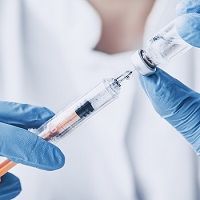Article
Baloxavir Effective in Preventing Spread of Flu
Author(s):
Baloxavir has positive effects in preventing flu in household contacts of patients with the illness.

New study findings shed light on the positive effects of baloxavir in preventing influenza (flu) in household contacts of patients with the illness.
In fact, single-dose baloxavir showed significant postexposure prophylactic efficacy.
Hideyuki Ikematsu, MD, and colleagues conducted a multicenter, double-blind, randomized, placebo-controlled trial. They evaluated the postexposure prophylactic efficacy of baloxavir in household contacts of index patients with confirmed flu during the 2018-2019 season in Japan.
The team identified index patients who had the first documented case of flu in a household from November 2018 through March 2019. Patients had a positive rapid flu diagnostic test and received antiviral treatment (baloxavir or neuraminidase inhibitor).
Participants were eligible if they were household contacts who had no influenza symptoms and an axillary temperature of less than 98.6 degrees Fahrenheit. Those eligible lived in the same household as the index patient for at least 48 hours before enrollment.
Each participant was randomly assigned in a 1:1 ratio to receive a single, weight-based oral dose of baloxavir or matching placebo. The randomization balanced 3 factors: time from onset of illness in the index patient to informed consent of the participant (less than 24 hours or at least 24 hours), treatment of index patient (baloxavir or neuraminidase inhibitor), and participant’s age (younger than 12 years old or at least 12 years old).
Axillary temperature was taken for each participant twice daily from screening until day 10. Those who were at least 12 years old monitored themselves for 7 flu-related symptoms: cough, sore throat, headache, nasal discharge or congestion, feverishness or chills, muscle or joint pain, and fatigue. Symptoms were rated on a four-point rating scale with 0 representing absent, 1 mild, 2 moderate, and 3 severe. If a participant was younger than 12 years old, their guardian assessed 2 symptoms, cough and nasal discharge or congestion, on the same rating scale.
Before the baloxavir or placebo were administered, nasopharyngeal swabs were obtained on day 1, day 5, and day 11. If participants had a fever and moderate or severe flu-like symptoms developed, they were instructed to visit the trial site for swabbing. The swab specimens were tested for influenza virus and virus type or subtype with reverse-transcriptase-polymerase-chain-reaction (RT-PCR) assay.
Ikematsu and the team’s primary efficacy endpoint was laboratory-confirmed clinical flu. Secondary clinical endpoints included RT-PCR-confirmed illness defined as RT-PCR positivity for influenza virus RNA plus a body temperature of at least 98.6 degrees Fahrenheit or at least 1 moderate or severe symptom, and RT-PCR-confirmed fly virus infection regardless of fever or symptoms.
Overall there were 752 household contacts with 545 index patients who were randomly assigned to receive either baloxavir or placebo. Of the index patients, 95.6% had influenza A, 73.6% were younger than 12 years old, and 52.7% were administered baloxavir.
For patients who were evaluated—374 in the baloxavir group and 375 patients in the placebo group—the percentage of those who developed clinical flu was significantly lower among the baloxavir group than placebo (1.9% vs 13.6%; aRR, .14; 95% CI, .06-.3; P <.001). Baloxavir was effective in subgroups of patients including high-risk, pediatric, and unvaccinated individuals.
Flu risk, regardless of symptoms, was lower in the baloxavir group (aRR, .43; 95% CI, .32-.58). The risk of adverse events was similar among both groups (baloxavir, 22.2% vs 20.5% in the placebo group).
The findings suggested the need to study the prophylactic efficacy of baloxavir in non-household settings, the study authors concluded.
The study, “Baloxavir Marboxil for Prophylaxis against Influenza in Household Contacts,” was published online in the New England Journal of Medicine.





